Med surg Blood Transfusion Module PDF

| Title | Med surg Blood Transfusion Module |
|---|---|
| Course | Nursing Care of Adults I |
| Institution | Texas A&M University-Corpus Christi |
| Pages | 12 |
| File Size | 434.4 KB |
| File Type | |
| Total Downloads | 45 |
| Total Views | 146 |
Summary
med surg blood transfusion module study ...
Description
Nursing Care of Adults 1: NURS 3628 Blood Module Introduction and Objectives The purpose of this learning module is to educate the student about blood, blood types, compatibility testing, blood products, types of transfusions, blood transfusion administration, and types and management of transfusion reactions. Upon completing the Blood Administration learning module, the student will be able to: 1. Identify ABO and Rh blood types and compatibilities. 2. Discuss blood products and the rationale for administering each type of blood product. 3. Identify the different types of transfusions. 4. Describe the nursing management of the patient receiving transfusions of blood and blood products. 5. Describe transfusion reactions. 6. Discuss the nursing management of transfusion reactions.
Blood Administration Learning Module Assignment Instructions: Read the Blood Component Therapy section, in your med/surg textbook. Read the NURS 3628 Blood Administration Learning Module. Read all websites embedded throughout the Blood Administration Learning Module. Take Blood Administration Module under the Assignment tab.
Introduction to Blood Administration Introduction Blood is a vital fluid. The blood carries oxygen, nutrients, hormones and other substances to the tissues and organs of the body and removes carbon dioxide and waste products. Illness or injury that affects the blood volume, oxygencarrying capability, or components of the blood may require blood transfusion as an intervention.
Blood Composition
Plasma: Approximately 55% of blood is plasma. Plasma is primarily water, but also contains electrolytes, proteins, hormones, gases, nutrients, and waste. Cellular components: Approximately 45% of the blood is made of cellular components: red blood cells (RBCs), white blood cells (WBCs), and platelets. The majority of cells are RBCs.
General Purposes of Blood Therapy
Restore and maintain blood volume. Improve oxygen-carrying capacity of blood. Replace blood components and clotting factors.
Blood Types
Blood types are based on the ABO system. The blood types are determined based on the presence of antigens on the red blood cell membrane. If you have no antigens in the blood then you are type O. Blood type O is the universal donor blood type. If you have A antigens, then you have type A blood. If you have B antigens, you have type B blood. If you have both antigens, then you have type AB blood. AB blood type is the universal recipient. Rhesus (Rh) factor, or "D" antigen, involves complex antigenic substances. If you have the D antigen, you are Rh positive. If you don't, you are Rh negative. People who are Rh negative can only receive Rh negative blood. Generally, Rh positive clients can receive either negative or positive. Rh factor can cause a problem in pregnant women if the mother is Rh negative and the first fetus is Rh positive. If not treated, the mother's antibodies may attack the RBCs of subsequent fetuses
who are Rh positive. This is prevented by treating the Rh negative mother with RhoGAM.
Compatibility Testing
Typing is conducted to ascertain the blood type and Rh factor. Crossmatch occurs when the lab takes blood from the patient and mixes it with blood from the units that will be transfused to examine for antibody/antigen reactions. The crossmatch may take several hours to complete and is one of the most critical pieces for preventing or reducing the risk of transfusion reactions. It is critical that the patient has a blood band armband that matches the sample taken for crossmatch as well as the blood bag. Human Leukocyte Antigen (HLA) testing may also be done to examine groups of antigens on leukocytes, platelets, and tissue cells. This is often used with multiple transfusions and for those at high risk for transfusion reactions.
Blood Products and Types of Transfusions Introduction This section reviews the types of blood products and the types of transfusions.
Blood Products
Whole blood is not commonly administered alone, but may be used for acute massive blood loss and replaces blood volume as well as blood components. It is most often used to extract specific blood elements. Packed Red Blood Cells (PRBCs) are prepared by removing plasma from the cellular components in whole blood. One unit is approximately 250 ml. Their purpose is to replace cells and improve oxygen carrying capacity of the cells. One unit of PRBCs generally increases the hematocrit by 3% and the hemoglobin by 1 gm/dl. Leukocyte poor, or leukocyte reduced, RBCs are used for patients at risk for
transfusion reactions or patients who have had febrile nonhemolytic transfusion reactions. The reduction of leukocytes is accomplished by centrifuge, washing, irradiating, or filtration. This process also reduces the risk for transmitting cytomegalovirus. Irradiation reduces graft vs. host disease. Platelets are given for people with clotting problems like thrombocytopenia as well as for those already hemorrhaging or who are at risk for bleeding because of a low platelet count. One unit of platelets (50-70 ml) generally increases the platelet count by approximately 10,000/µL. Fresh frozen plasma (FFP) is used to preserve or replace clotting factors and expand blood volume. They must be thawed before being given and each unit is about 200 ml. Clotting factors (cryoprecipitate) such as factor VIII are used for those with clotting problems. Cryoprecipitate is derived from plasma. Albumin. Albumin does not need screening and is used for volume expansion. Administration differs from other blood products. It is a plasma derivative. The volume depends on the ordered percentage given.
Types of Transfusions
Autologous: the person has donated their own blood to be transfused. This is usually done for patients who know they will be undergoing surgery. Cell saver and blood salvage devices also are considered autologous in nature. Homologous or allogenic: donated blood. Read the American Red Cross website Getting Ready for a Donation and the Donation Process about what to expect when donating blood and blood donation eligibility guidelines. o Blood Eligibility Guidelines
Administering Blood Products
Introduction This section reviews a procedure for administering blood. The procedure is based on PRBCs, therefore administration of platelets and FFP administration may differ. Individual facility policy and procedure may also vary.
Blood Administration Procedure 1. Verify the patient's identity and explain procedure to patient. Obtain verbal consent. Many facilities now require signed consent. Review signs and symptoms of transfusion reaction. Ask patient if has ever had a transfusion and/or if has a history of transfusion reaction.
2. Obtain a baseline assessment, including vital signs, neurological, cardiovascular, and pulmonary assessments. Some texts state you do the assessment immediately prior to starting blood. Some texts state you do the assessment before getting blood and again just prior to beginning transfusion. If the patient is febrile, you will want to obtain special permission to continue with the blood transfusion.
3. Review the order. Check to see if patient has current blood bank armband and units available in the blood bank. If not, obtain order for
type and crossmatch.
4. Gather equipment: 0.9% normal saline solution, straight or Y-type blood transfusion set, extra set of primary tubing, IV start supplies (as needed), IV infusion pump (if policy requires), and leukocyte filter (if ordered). The equipment is usually gathered once blood is ready. Some texts state you should have additional tubing available in case of emergency. 5. Start an IV if necessary: start an IV with at least 20-gauge needle. The preferred size is an 18-gauge catheter. This decreases the risk of causing hemolysis to the red blood cells.
6. Premedicate the patient if ordered. (Some patients may need to be premedicated with antihistamines, diuretics, or antipyretics).
7. Get the blood from blood bank (may be able to delegate). You will need to send a requisition slip (which asks why the patient is receiving blood). This is a good time to double check the order. Once in the blood bank, you will sign several forms that you witnessed the lab technician check the blood's color and consistency and checked the bag for leaks and any abnormalities. You will verify that the patient's name, ID number, blood type, Rh factor, blood donor number, blood product type, and expiration date on the requisition matches what is on the unit of blood.
8. Check the blood with a second RN: verify the order, patient's name, ID number, blood bank number, unit number, expiration date, blood product, blood type, Rh factor, and expiration date. These items must be checked in the patient's room so both nurses can check actual patient armband and blood bank tag. Also inspect the bag again for leaks and for anything abnormal, such as color, clots, or bubbles. If there are any discrepancies or concerns, send the unit back to the blood bank. The person witnessing the check should sign the blood administration forms.
9. Wash your hands. Assemble equipment (this may be done right before you go to pick up the blood): set up and prime blood tubing (may have two spikes - one for blood and one for saline) with ONLY 0.9 % NS. Use tubing designated for blood. Do NOT add meds to the bag and do NOT give medication through an IV line containing blood. Use a blood filter if one is not on the tubing; apply the leukocyte filter as needed in addition to blood filter. You can start NS at a keep vein open (KVO) rate once the IV is started as ordered or per policy. Generally, it is preferable to prime blood tubing with NS even if it only has one spike.
10. Reassess the patient's condition, including vital signs, level of consciousness, respiratory and cardiovascular status.
11. Wear gloves. Connect the blood to the Y-tubing and stop the saline. Start the blood (only if blood matches the patient) slowly for the first 15 minutes (no more than 50 ml should be administered in first 15 minutes) and then increase rate so that transfusion infuses in 2 - 4 hours. Blood should be started within 30 minutes of obtaining it from blood bank. If this cannot be done, return the unit to blood bank. Document start time.
12. Monitor the patient closely for first 15 minutes (many hospitals require the nurse to stay with the patient during this time). Take vitals every 5 minutes for the first 15 minutes or per hospital protocol. Be sure that you are monitoring the patient closely once the blood is actually infusing into the patient. If the patient develops signs and symptoms of a reaction, stop the transfusion.
13. During the transfusion, the IV Nurses Association suggests that you monitor the patient at least every 30 minutes during the transfusion and again 30 minutes post transfusion. You will still follow transfusion reaction protocol if the patient develops a reaction after the initial 15 minutes.
14. After the transfusion is completed, restart the saline and turn off the blood. Allow enough saline to flush blood through the tubing. Document outcomes, vitals, etc.
General Rules of Blood Transfusions
Don't leave unused bags of blood out of fridge for more than 30 minutes. Return to blood bank if unable to administer in under 30 minutes; do not store in refrigerator on nursing unit. Don't warm blood in microwave or in warm water. Blood warmers may be used as necessary. Know what the transfusion reaction signs and symptoms are and what to do about them. Document the process carefully. If there are no problems, state "no reactions." Transfuse the blood in 4 hours or less, depending on the type of blood product being administered. Follow universal precautions. Monitor the patient closely for first 15 minutes (many hospitals require the nurse to stay with the patient during this time). Take vitals every 5 minutes for the first 15 minutes or per hospital protocol. Be sure that you are monitoring the patient closely once the blood is actually infusing into the patient. If the patient develops signs and symptoms of a reaction, stop the infusion.
Right to Refuse Transfusion Readings
AHRQ Case & Commentary "No Blood, Please" Georgetown College v. Jones Further Readings
Transfusion Reactions Introduction Transfusion reactions are reactions to blood therapy that can range from mild to life-threatening. This section discusses transfusion reactions and then summarizes the general rules for managing a transfusion reaction.
Acute transfusion Reactions
Acute hemolytic reactions (Type 2 cytotoxic hypersensitivity reaction): cells hemolyze because of an antigen/ antibody reaction between the patient's blood and the donor's blood. Often related to ABO incompatibility. Signs and symptoms include: fever, chills, low back pain, tachycardia, tachypnea, brown or red urine, hypotension. Patient may show signs of acute renal failure, shock, cardiac arrest, and disseminated intravascular coagulation (DIC). Stop the transfusion. Attach new tubing with 0.9% NS and run at KVO. Treat shock. Send lab samples and start urine catheter per hospital protocol. Tubing and blood will go to blood bank. Obviously notify the MD and document.
Febrile nonhemolytic reactions (most common): happens because antibodies in the
recipient react to WBCs in the donor's blood. Signs and symptoms include fever (increased temperature of one (1) degree Celsius or more), sudden chills, headache, flushing, anxiety, aches, pain, possibly shortness of breath, anxiety, nausea and vomiting. Stop the infusion, attach new tubing with 0.9% NS and run at KVO. Notify the MD and blood bank. Monitor vital signs and administer medication as ordered and document. MD may order antipyretics and antihistamines. Allergic reactions: o Mild allergic: caused because of sensitivity to foreign plasma proteins. Signs and symptoms include flushing, itching, and hives. Stop the infusion. Contact physician. Administer ordered antihistamines or epinephrine. o Anaphylactic reaction: caused by sensitivity to foreign plasma proteins. May also occur because of Immunoglobulin A sensitivity. Signs and symptoms include anxiety, cyanosis, hypotension, shock, hives, wheezing, angioedema. Stop the transfusion. May need epinephrine, antihistamines, steroids, and even CPR. Will want IV of 0.9% NS with new tubing. Fluid overload: happens because blood is being given too fast for circulation to keep up. Signs and symptoms: cough, dyspnea, signs of CHF, distended neck veins, headache, hypertension, pulmonary congestion, pulmonary edema. Stop the transfusion. Administer oxygen to the patient and elevate the head of the bed with feet dependent. It is possible diuretics or morphine will be given. Sepsis: happens because of contaminated blood products, IV site, or equipment. Signs and symptoms include sudden onset of chills, high fever, severe hypotension, nausea/ vomiting, shock. Stop the transfusion. Attach new tubing with 0.9% NS. Notify MD. May draw blood cultures. Patient will receive antibiotics, steroids, fluids, vasopressors. Blood and tubing should go to blood bank. Transfusion related acute lung injury (TRALI): Although rare, TRALI is the leading cause of mortality caused by transfusions. It occurs within six hours of a transfusion. It is thought to be caused by an immune mediated response. It is difficult to diagnose and will usually present like Acute Respiratory Distress Syndrome (ARDS). Treatment is supportive with stopping the transfusion, getting help, administering oxygen, monitoring oxygen saturation and vital signs, and obtaining an order for a chest x-ray. As with all trasnfusion reactions, send blood and tubing to the blood bank for evaluation.
General "Rules" for Treating a Suspected Acute Transfusion Reaction 1. STOP the transfusion! 2. Maintain a patent IV line of NS 0.9% at KVO (should use new tubing). 3. Have someone call the rapid response team (as needed), the healthcare provider, and the blood bank. 4. Double check that the blood bag label matches the patient armband. 5. Monitor the patient and the vitals and treat appropriately (for shock, anaphylaxis). Compare the vitals with the initial set. 6. Monitor the respiratory status. Start oxygen if needed. You may want to have a crash cart available. 7. Send the blood back to the blood bank along with urine, blood, and any other specimens. 8. Follow the MD's orders and the transfusion reaction protocol. 9. Document on the appropriate forms - usually the patient chart and a transfusion reaction form.
Delayed Transfusion Reactions
Delayed hemolytic transfusion can be caused by ABO incompatibility. Signs and symptoms include persistent fever, mild jaundice, and decreasing hematocrit. Signs and symptoms occur as early as three days or as late as several months after a transfusion. Generally occurs 1-2 weeks post transfusion. The MD and the blood bank should be notified. The patient may or may not need additional treatment, including another transfusion. The patient may present with diseases such as Hepatitis B, Hepatitis C, HIV, CMV, iron overload and malaria. Graft vs. host disease is caused by infusing lymphocytes into a patient who is immunocompromised. The donor's lymphocytes will replicate (graft) into the recipient (host). This can occur days to months after transfusion. Signs and symptoms include fever, rash, and diarrhea. The MD and the blood bank should be notified. There is no treatment, but this can be prevented if blood is irradiated prior to transfusion.
Transfusion Reaction Readings
Puget Sound Blood Center Blood Component Therapy Blood Transfusion: Safer Than Ever...
Similar Free PDFs

Med surg Blood Transfusion Module
- 12 Pages

Blood Transfusion
- 2 Pages

Blood Transfusion worksheet
- 4 Pages

Blood Transfusion Nursing Skill
- 1 Pages

Blood transfusion reaction
- 6 Pages

Blood Transfusion Nclex Review
- 18 Pages
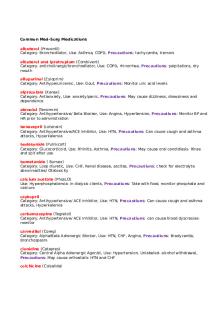
Common Med Surg Meds
- 7 Pages

Med surg dorris bowman
- 4 Pages
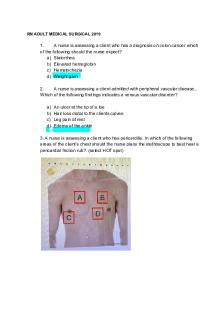
Med surg - notes
- 28 Pages
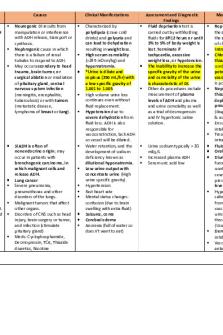
Med-Surg Endocrine
- 11 Pages
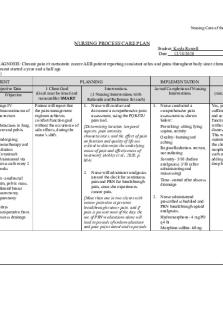
Med Surg- Care Plan
- 6 Pages
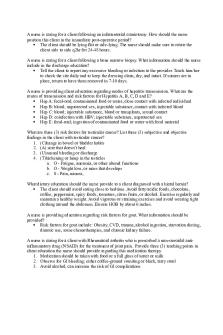
Med-Surg Capstone remediation
- 4 Pages

Med Surg Exam 3
- 19 Pages
Popular Institutions
- Tinajero National High School - Annex
- Politeknik Caltex Riau
- Yokohama City University
- SGT University
- University of Al-Qadisiyah
- Divine Word College of Vigan
- Techniek College Rotterdam
- Universidade de Santiago
- Universiti Teknologi MARA Cawangan Johor Kampus Pasir Gudang
- Poltekkes Kemenkes Yogyakarta
- Baguio City National High School
- Colegio san marcos
- preparatoria uno
- Centro de Bachillerato Tecnológico Industrial y de Servicios No. 107
- Dalian Maritime University
- Quang Trung Secondary School
- Colegio Tecnológico en Informática
- Corporación Regional de Educación Superior
- Grupo CEDVA
- Dar Al Uloom University
- Centro de Estudios Preuniversitarios de la Universidad Nacional de Ingeniería
- 上智大学
- Aakash International School, Nuna Majara
- San Felipe Neri Catholic School
- Kang Chiao International School - New Taipei City
- Misamis Occidental National High School
- Institución Educativa Escuela Normal Juan Ladrilleros
- Kolehiyo ng Pantukan
- Batanes State College
- Instituto Continental
- Sekolah Menengah Kejuruan Kesehatan Kaltara (Tarakan)
- Colegio de La Inmaculada Concepcion - Cebu


